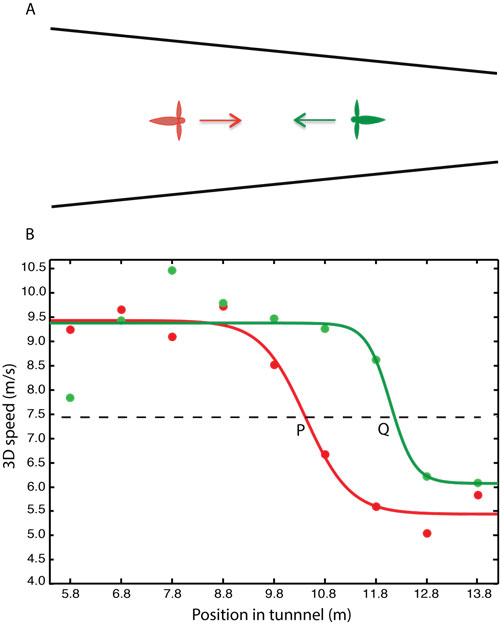Although long-range navigation of birds has been studied extensively, relatively little attention has been devoted to investigating moment-to-moment flight, and to understanding how birds adapt their flight to the environment through which they are moving. This study was conducted within the framework of an HFSP grant entitled “Visual control of flight modes and transitions in birds”. Budgerigars were filmed as they flew along a 14 m long tapered tunnel, 1.4 m wide at one end, and 0.6 m wide at the other (Fig. 1A). Analysis of the flight trajectories revealed that the birds flew at two distinct speeds: ca. 10 m/s in the wider section of the tunnel, and ca 6m/s in the narrower section (Fig. 1B). The transition between the two speeds was not gradual – it was rapid and abrupt (Fig. 1), suggesting that the birds did not favour flight at the intermediate speeds. The position (P) in the tunnel at which the birds switched from the high speed to the low speed when flying in the narrowing direction was different from the position (Q) at which they switched from the low speed speed to the high speed when flying in the opposite (widening) direction. This ‘hysteresis’ in the switching behavior suggests that the birds are changing their speeds in an anticipatory manner, by gauging the width of the tunnel approximately 1m ahead of their current position.

Fig. 1 Budgerigar flight in a tapered tunnel. (A) plan view of tunnel, showing the two flight directions. (B) Flight speed profiles. Data were collected and averaged from 10 birds, each performing 4 flights in the narrowing direction (red points) and 4 flights in the widening direction (green points). The curves represent logistic functions fitted to the data. The birds switch from the high speed to the low speed at the location P when flying in the narrowing direction, and from the low speed to the high speed at the location Q when flying in the widening direction.
The tendency of budgerigars to fly at one or the other of two preferred speeds, and to avoid all other speeds, is different from that of insects, which vary their speed gradually, and approximately linearly as they fly through a tapered tunnel [2]. In budgerigars, the high speed coincides with the speed at which these birds cruise in open outdoor environments – and which happens to be the speed that is most energy-efficient, as demonstrated by earlier wind tunnel studies. The low speed may be a ‘maneuvering’ speed that is used for navigating safely in cluttered environments. One advantage of using fixed, known flight speeds is that the distances to objects and obstacles in the environment can be calibrated directly in terms of the image motion (optic flow) that they generate in the eyes.
References
[1] Budgerigar flight in a varying environment: flight at distinct speeds? Schiffner, I, and Srinivasan, MV (2016) Biology Letters 12.6: 20160221.
[2] Honeybee navigation en route to the goal: visual flight control and odometry.Srinivasan, M.V., Zhang, S.W., Lehrer, M. and Collett, T.S. (1996) Journal of Experimental Biology 199, 237-244.


































